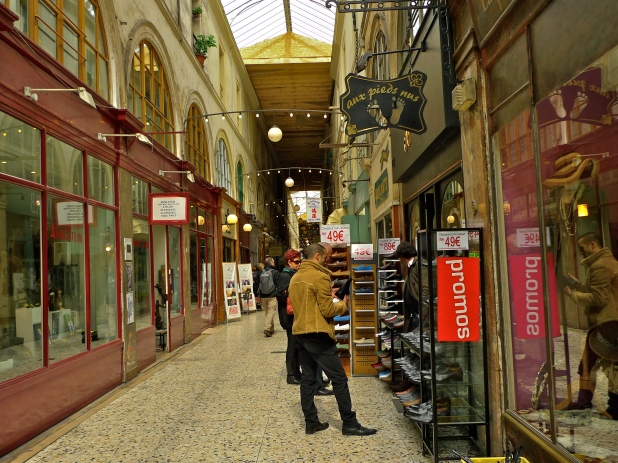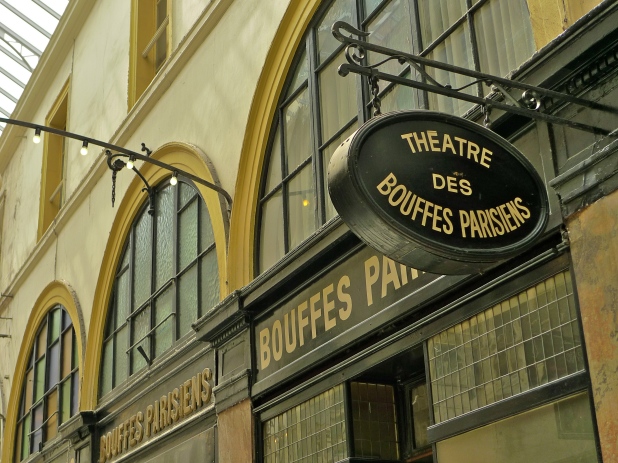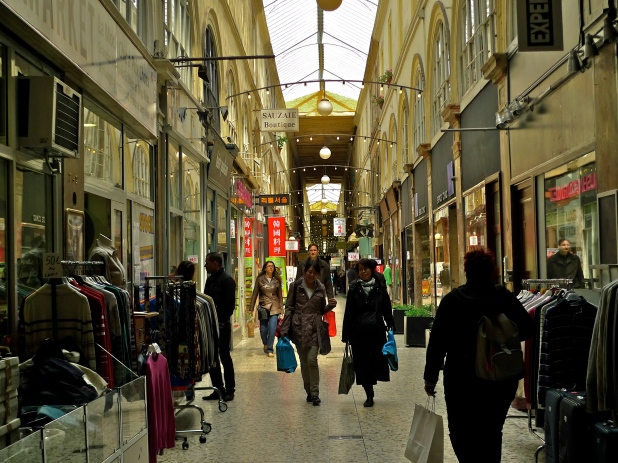Passage Choiseul – A Soundwalk
FOR SOME TIME NOW as part of my Paris Soundscapes project I’ve been recording and archiving the contemporary sounds in each of the twenty surviving nineteenth-century passage couverts in Paris. The Passage Choiseul in the 2nd arrondissement is latest of these passages to be added to my collection.
Work began on the Passage Choiseul in 1825 and it took two years to complete. The architect, François Mazois, came up with the original design but he died before the work was completed and so another architect, Antoine Tavernier, took over.
Like all the passages couverts, the Passage Choiseul resembles a street with two rows of boutiques on the ground floor with living accommodation above joined together by a glass roof. At 190 metres long this is the longest of the surviving passages couverts and it’s registered as an historic monument. The floor originally comprised grey sandstone floor tiles but they were covered over in the 1970’s with the speckled tiles we see today.
Like in so many of the passage couverts, the glass roof in the Passage Choiseul suffered over the years. It was replaced in 1907 but the ravages of time took a further toll and it once again descended into a sorry state. Recently, a young architect, Raphaël Bouchmousse, 32, came up with a proposal to renovate the roof at a cost of €740,000. The proposal was accepted and in May 2012 the work began. It’s now completed and the roof has returned to its former glory.
A Soundwalk in the Passage Choiseul:
The Passage Choiseul has a long association with the arts. Anatole France, a French poet, journalist, novelist and winner of the Nobel Prize for Literature, worked here as a proof-reader from 1867 to 1876. Louis-Ferdinand Céline the French novelist, pamphleteer and physician, lived here as a child. His mother, Marguerite Destouches, owned a curiosity shop in the passage. Alphonse Lemeere published the first poems of Paul Verlaine from here in 1864 as well as the works of the Parnassians who embraced a French literary style that began during the 19th century. Today, the former publishing house of Alphonse Lemeere is occupied by the painter and sculptor, Anna Stein.
Another occupant of the Passage Choiseul is the rear entrance to the Théâtre des Bouffes Parisiens.
Inaugurated in 1855 by the composer Jacques Offenbach, the theatre was especially built to perform his opéra-bouffes. Orphée aux Enfers (Orpheus in the Underworld) was premiered here in 1858, La Belle Hélène in 1864 and La Vie Parisienne and Barbe-Bleue in 1866.
The main entrance to the theatre is in the neighbouring street, rue Monsigny.
After early success, like all the other passages couverts the passage Choiseul entered a period of decline. Its fortunes were revived in the 1970’s when the French actress, Sophie Desmarets, opened an antique shop here, Cactus Bazar. This was followed by Kenzo’s first fashion boutique, Jungle Jap, which has now moved to the Place des Victoires.
Today, the Passage Choiseul hosts Japanese eateries, clothing stores, jewellery shops, art galleries and art supply shops, as well as a plentiful supply of shoe shops.
The Passage Choiseul is to be found at:
40, rue Petits-Champs / 23, rue Saint-Augustine / 40, rue Dalayrac
Métro: Quatre-Septembre
And you can see more of my collection of les passages couverts here.

















Today it’s gray, windy and cold — exactly the kind of weather that would drive me to explore one of Paris’ passages couverts. Thank you for giving me an opportunity to do exactly that! I’d never heard of the Passage Choiseul, so I greatly appreciated your combination of historical facts and first-hand observations (and your lovely recording as well, naturally). Well done!
Thanks Heather. I’ve now documented 11 of the surviving 20 passages couverts so I still have more to do. I find them absolutely fascinating.
Your weather today seems to be just like ours but it hasn’t deterred me from recording the Fête du Travail today. 200,000 people on the streets protesting about everything imaginable! So that’s my next blog post done then!
Not that sound is ever static, but here you have really managed to capture a movement of sound through space … people walking from left to right, from foreground to background. Nicely done!
Thanks JD. Recording in places like this requires endless patience. It’s a matter of waiting for just the right moment.